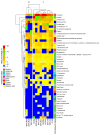Changes in Chemical Composition of Lentils, Including Gamma-Aminobutyric Acid and Volatile Compound Formation during Submerged and Solid-State Fermentation with Pediococcus acidilactici
- PMID: 38672920
- PMCID: PMC11049090
- DOI: 10.3390/foods13081249
Changes in Chemical Composition of Lentils, Including Gamma-Aminobutyric Acid and Volatile Compound Formation during Submerged and Solid-State Fermentation with Pediococcus acidilactici
Abstract
The aim of this study was to evaluate and compare the characteristics of non-treated and fermented [via submerged (SMF) and solid-state (SSF) fermentation using Pediococcus acidilactici] lentils (Lens culinaris) grown either in pure stands (L) or relay intercropped with winter rye (LR). It was observed that the lentils were suitable substrate for lacto-fermentation. Most of the free amino acid concentrations increased in lentils after both fermentations. The highest concentration of γ-aminobutyric acid was found in SSF LR samples. However, fermentation led to higher biogenic amines (BA) content in lentils. The most abundant fatty acid in lentils was C18:2. SSF lentils showed more complex volatile compound (VC) profiles (with between nine and seventeen new VCs formed), whereas, in SMF samples, between two and five newly VCs were formed. When comparing lentil grown types, L contained significantly higher concentrations of Na, K, Ca, P, Mn, and Se, while LR contained significantly higher concentrations of Fe and Ni. To sum up, fermentation with lactic acid bacteria (LAB) contributed to the improved biological value of lentils; still, the quantity of BA needs to be considered. Further investigations into the P. acidilactici metabolism of certain compounds (such as phenolic and antinutritional compounds) in lentils during fermentation ought to be carried out.
Keywords: amino acids; biogenic amines; fatty acids; fermentation; gamma-aminobutyric acid; lentils; trace elements; volatile compounds.
Conflict of interest statement
The authors declare no conflicts of interest.
Figures



References
-
- Kaale L.D., Siddiq M., Hooper S. Lentil (Lens culinaris Medik.) as Nutrient-Rich and Versatile Food Legume: A Review. Legume Sci. 2023;5:e169. doi: 10.1002/leg3.169. - DOI
-
- Johnson N., Johnson C.R., Thavarajah P., Kumar S., Thavarajah D. The Roles and Potential of Lentil Prebiotic Carbohydrates in Human and Plant Health. Plants People Planet. 2020;2:310–319. doi: 10.1002/ppp3.10103. - DOI
-
- Zhang B., Deng Z., Ramdath D.D., Tang Y., Chen P.X., Liu R., Liu Q., Tsao R. Phenolic Profiles of 20 Canadian Lentil Cultivars and Their Contribution to Antioxidant Activity and Inhibitory Effects on α-Glucosidase and Pancreatic Lipase. Food Chem. 2015;172:862–872. doi: 10.1016/j.foodchem.2014.09.144. - DOI - PubMed
-
- Li M., Xia M., Imran A., de Souza T.S.P., Barrow C., Dunshea F., Suleria H.A.R. Nutritional Value, Phytochemical Potential, and Biological Activities in Lentils (Lens culinaris Medik.): A Review. Food Rev. Int. 2023:1–31. doi: 10.1080/87559129.2023.2245073. - DOI
LinkOut - more resources
Full Text Sources
Miscellaneous

